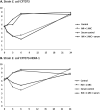Analysis of Paradoxical Efficacy of Carbapenems against Carbapenemase-Producing Escherichia coli in a Murine Model of Lethal Peritonitis
- PMID: 32423956
- PMCID: PMC7526833
- DOI: 10.1128/AAC.00853-20
Analysis of Paradoxical Efficacy of Carbapenems against Carbapenemase-Producing Escherichia coli in a Murine Model of Lethal Peritonitis
Abstract
The clinical benefit of carbapenems against carbapenemase-producing Enterobacteriaceae (CPE) remains in question. MICs of imipenem (IMP) and ertapenem (ERT) against isogenic derivatives of the wild-type strain Escherichia coli CFT073 producing KPC-3, OXA-48, or NDM-1 were 0.25, 2, 16, and 64 mg/liter for IMP and 0.008, 0.5, 8, and 64 mg/liter for ERT, respectively. Swiss ICR-strain mice with peritonitis were treated for 24 h with IMP or ERT. Despite a limited duration of time during which free antibiotic concentrations were above the MIC (down to 0% for the NDM-1-producing strain), IMP and ERT significantly reduced bacterial counts in spleen and peritoneal fluid at 24 h (P < 0.005) and prevented mortality. Several possible explanations were investigated. Addition of 4% albumin or 50% normal human serum did not modify IMP activity. Bacterial fitness of resistant strains was not altered and virulence did not decrease with resistance. In the presence of subinhibitory concentrations of ERT, growth rates of OXA-48, KPC-3, and NDM-1 strains were significantly decreased and filamentation of the NDM-1 strain was observed. The expression of blaNDM-1 was not decreased in vivo compared to in vitro No zinc depletion was observed in infected mice compared with Mueller-Hinton broth. In conclusion, a paradoxical in vivo efficacy of IMP and ERT against highly resistant carbapenemase-producing E. coli was confirmed. Alternative mechanisms of antibacterial effects of subinhibitory concentrations of carbapenems may be involved to explain in vivo activity. These results are in agreement with a potential clinical benefit of carbapenems to treat CPE infections, despite high carbapenem MICs.
Keywords: Escherichia coli; antibiotic resistance; carbapenemase; carbapenems; peritonitis.
Copyright © 2020 American Society for Microbiology.
Figures





References
-
- Daikos GL, Tsaousi S, Tzouvelekis LS, Anyfantis I, Psichogiou M, Argyropoulou A, Stefanou I, Sypsa V, Miriagou V, Nepka M, Georgiadou S, Markogiannakis A, Goukos D, Skoutelis A. 2014. Carbapenemase-producing Klebsiella pneumoniae bloodstream infections: lowering mortality by antibiotic combination schemes and the role of carbapenems. Antimicrob Agents Chemother 58:2322–2328. doi:10.1128/AAC.02166-13. - DOI - PMC - PubMed
-
- Tumbarello M, Viale P, Viscoli C, Trecarichi EM, Tumietto F, Marchese A, Spanu T, Ambretti S, Ginocchio F, Cristini F, Losito AR, Tedeschi S, Cauda R, Bassetti M. 2012. Predictors of mortality in bloodstream infections caused by Klebsiella pneumoniae carbapenemase-producing K. pneumoniae: importance of combination therapy. Clin Infect Dis 55:943–950. doi:10.1093/cid/cis588. - DOI - PubMed
MeSH terms
Substances
LinkOut - more resources
Full Text Sources
Research Materials
Miscellaneous

